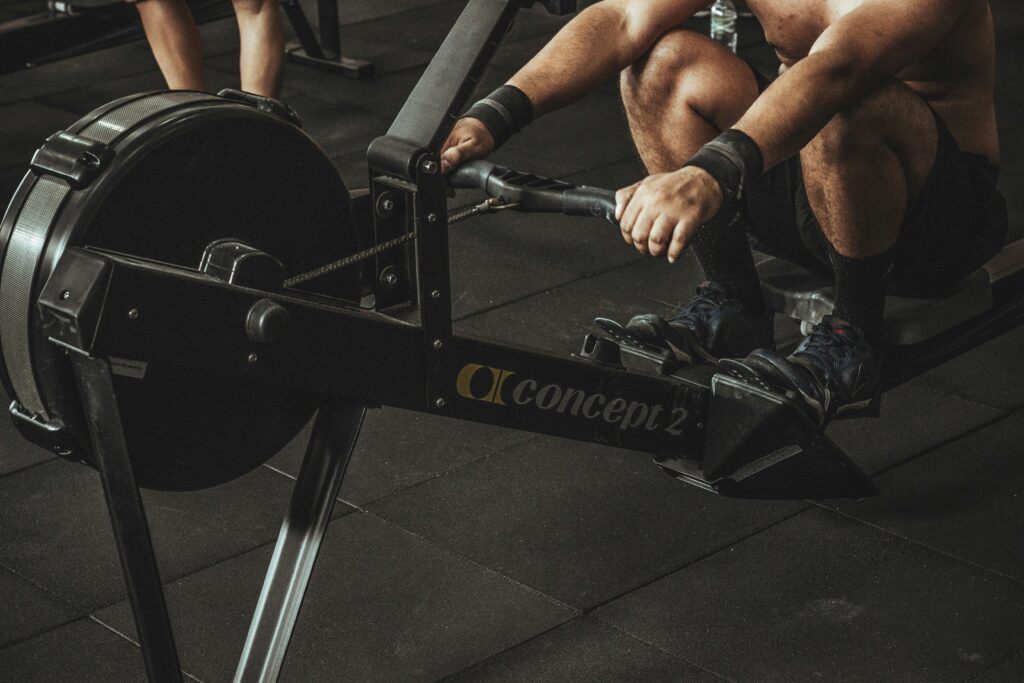
Hey there,
If you’re like me, you’ve probably found yourself torn between the allure of a rowing machine and the serene experience of water rowing.
Deciding between the convenience of indoor rowing, vs the natural experience of outdoor rowing can be a bit of a puzzle…
Imagine the tranquil rhythm of your oars cutting through water on a calm morning. It’s peaceful, almost meditative.
Now, contrast that with the practicality of hopping on a rowing machine at home, squeezing in a quick yet effective workout without the need to leave your house.
Both have their undeniable benefits, yet they cater to different needs and preferences. For many, water rowing offers a connection with nature that’s hard to match, a chance to enjoy the scenery and fresh air.
On the flip side, indoor rowing shines in its convenience, allowing for a great workout regardless of weather conditions or time constraints.
Whether you’re an enthusiast craving the calmness of open water or someone looking for the sheer convenience of indoor training, understanding the pros and cons of each can help you make the best choice for you.
Brief overview of rowing as a fitness activity
Rowing is a stellar fitness activity (a biased opinion, I know…), renowned for its ability to improve cardiovascular health and provide a low-impact, full-body workout.
Unlike many forms of exercise that focus on specific muscle groups, rowing engages almost every major muscle, ensuring a balanced and comprehensive fitness regimen.
The rhythmic motion of rowing enhances both strength and endurance, making it an ideal workout for those looking to increase their overall fitness levels. However, when it comes to choosing between indoor and outdoor rowing, each has its unique pros and cons.
Accessibility is a major factor. Indoor rowing, (typically on a rowing machine), offers the convenience of being able to work out anytime, regardless of weather or location. And as we all know, consistency is crucial for our long-term fitness goals!
Outdoor rowing, on the other hand, adds an element of nature and fresh air, making the rowing experience more enjoyable and mentally refreshing.
Both forms are equally effective in delivering a good workout, but the choice ultimately depends on personal preference and lifestyle. Whether you enjoy the controlled environment of a gym or the scenic beauty of a lake, rowing at your own pace ensures that you can customize the workout to fit your needs.

Importance of choosing the right type of rowing for your goals and preferences
As I mention in (nearly) every rowing article I write, the main factor to consider is your fitness goals and personal preferences.
If your primary goal is to achieve a high level of cardiovascular fitness and muscular strength, both indoor and outdoor rowing can meet these needs effectively. However, the choice becomes clearer when personal preferences are taken into account.
- Outdoor rowing provides benefits such as improved mental health, by reducing stress and offering a sense of peace. I find that the connection with nature makes the workout feel less like a chore and more like a joy.
- On the other hand, indoor rowing is perfect for those who value convenience and consistency. It is suitable for all fitness levels, allowing you to control the intensity and duration of your workout at your own pace, without being influenced by external factors like weather conditions.
What are the Pro’s and Cons of Indoor vs Outdoor Rowing?
Weighing the advantages and disadvantages of indoor and outdoor rowing
Let’s first look at the the benefits of indoor versus outdoor rowing – it’s important to weigh the specific advantages and disadvantages of each (obviously!)
The Case for Indoor Rowing

Indoor Rowing Pros
- Weather Independence: Indoor rowing is unaffected by weather conditions, allowing for consistent training regardless of rain, wind, or temperature extremes.
- Accessibility: Requires only access to a rowing machine, making it convenient to practice at home or in a gym without needing to travel to a body of water.
- Controlled Environment: Provides a predictable and stable environment, which is ideal for those who prefer structured and measured workouts.
- Versatility: Suitable for all fitness levels and can be easily adjusted to fit individual training needs, making it inclusive for beginners to advanced rowers.
- Convenience: Allows for quick and efficient workouts, fitting easily into busy schedules without the need for extensive setup or travel.
Indoor Rowing Cons
- Monotony: The repetitive nature of indoor rowing can become monotonous over time, potentially leading to decreased motivation and engagement.
- Lack of Scenery: Indoor rowing lacks the scenic and tranquil environment provided by outdoor rowing, which can make the experience feel less enjoyable.
- Air Quality: Exercising indoors may not provide the same fresh air benefits as rowing outside, which can affect the overall workout experience.
- Limited Space: Not everyone has enough space at home for a rowing machine, and access to a gym may not be convenient for everyone.
- Artificial Resistance: The resistance provided by a rowing machine may not fully replicate the natural variability of water resistance, potentially affecting the authenticity of the rowing experience.
The Case for Outdoor Rowing

Outdoor Rowing Pros
- Scenic and Tranquil Environment: Offers a connection with nature, providing a peaceful and visually stimulating experience that can enhance mental well-being.
- Natural Resistance: Engaging with real water conditions adds a layer of resistance and variability, which can improve rowing skills and endurance.
- Fresh Air: Being outdoors provides the benefits of fresh air and natural surroundings, which can enhance the overall enjoyment and health benefits of the workout.
- Team Building: Often done in groups or teams, outdoor rowing can foster a sense of community and teamwork, adding a social aspect to the exercise.
- Engagement: The dynamic environment of rowing on water can be more engaging and motivating, helping to keep workouts interesting and enjoyable.
Outdoor Rowing Cons
- Weather Dependence: Outdoor rowing is heavily influenced by weather conditions, which can disrupt training schedules due to rain, wind, or extreme temperatures.
- Accessibility Issues: Requires access to a suitable body of water, which may not be readily available for everyone, limiting the opportunity to row regularly.
- Safety Concerns: Outdoor rowing can pose safety risks such as strong currents, collisions, or adverse weather, which are not factors in indoor rowing.
- Setup Time: Preparing for outdoor rowing involves more setup and travel time, including transporting equipment and getting to and from the rowing location.
- Team Dependency: Often requires coordination with a team or rowing club, which can be less flexible than indoor rowing where you can work out solo at your convenience.
Factors to Consider
Deciding between indoor, or outdoor rowing involves several factors, including fitness goals, available space, and personal preferences.
If your primary aim is to improve cardiovascular health and overall fitness, both methods can be effective. However, the choice may come down to practical considerations such as space and budget.
Indoor rowing requires access to a rowing machine, which can fit conveniently into most home gyms or fitness centers, making it an attractive option for those with limited space.
On the other hand, outdoor rowing necessitates access to a suitable body of water, which might not be feasible for everyone (like me, unfortunately!).
Personal preferences also play a crucial role; some may prefer the controlled environment of indoor rowing, enjoying the predictability and structure it offers. Others might value the scenic and tranquil nature of outdoor rowing, finding motivation and peace in the natural surroundings.
Budget is another consideration; while a rowing machine is a one-time investment, outdoor rowing might involve ongoing costs for equipment and potential membership fees at rowing clubs.
Indoor Rowing vs Outdoor Rowing: Key Differences
Muscles worked: similarities and differences
Rowing, whether indoors or outdoors, provides a comprehensive full-body workout that engages almost 85% of your muscles. A great option for those of us looking to add some muscle definition to their upper body.
This includes major muscle groups in the upper body, lower body, and core. However, there are subtle differences in muscle engagement between the two forms.
Outdoor rowing often requires more core engagement due to the need to balance the boat on water, which can add an extra dimension to the workout. The instability of the water forces rowers to stabilize their movements, thereby intensifying core activation.
Conversely, while indoor rowing still targets the core muscles, the stable surface of a rowing machine means less core stabilization is required. This difference makes outdoor rowing slightly more challenging in terms of core engagement, though both forms of rowing offer an effective full-body workout.

Calories burned: which type of rowing is more effective for weight loss?
If your goal is to burn calories and promote weight loss, both indoor and outdoor rowing are highly effective.
The exact number of calories burned depends on factors such as body composition, workout intensity, and resistance level.
Indoor rowing machines offer the advantage of providing consistent resistance levels, which can be precisely adjusted to maintain a challenging workout throughout the session. This predictability makes it easier to track progress and manage calorie expenditure.
Outdoor rowing can be influenced by undercurrents and weather conditions, which may cause variations in workout intensity. While this variability can add to the challenge and potentially increase calorie burn, it also makes it harder to maintain consistent resistance levels.
Personally, I enjoy the unpredictability of the elements when rowing on-water. It adds excitement, and I tend to notice the muscle pain less if there’s a nice view to focus on instead.
Both types of rowing can contribute significantly to weight loss, but the controlled environment of indoor rowing might offer a slight edge in managing and maximizing calorie burn.
Difficulty level: which type of rowing is more challenging?
Outdoor rowing generally presents a more challenging workout compared to its indoor counterpart.
This increased difficulty stems from the need to navigate open water, which involves dealing with unpredictable weather conditions and water currents. The physical demand of steering and stabilizing the boat can significantly elevate the intensity of the workout.
Indoor rowing is more predictable, as it eliminates the variables of weather and water conditions. This stability allows rowers to focus solely on their form and intensity without the additional challenge of balancing.
While an indoor rower can still achieve a rigorous and challenging workout, the controlled environment and absence of external factors make it less demanding than outdoor rowing.
Additionally, many modern indoor rowing machines are equipped with features like a Bluetooth monitor, which can aid in tracking performance and ensuring a consistent workout, further differentiating the experiences of indoor and outdoor rowing.
Tips for Deciding Between Indoor and Outdoor Rowing
How to choose the right type of rowing for your lifestyle and goals
Choosing between indoor and outdoor rowing depends on several factors which are listed below:
- If you aim to monitor your heart rate and track precise metrics like distance, indoor rowing might be more suitable due to the advanced features of modern rowing machines.
- Consider your budget as well—indoor rowing requires a one-time investment in equipment, whereas outdoor rowing might involve ongoing membership fees and costs for maintaining rowing gear.
- Reflect on whether you enjoy the predictability of indoor environments or the dynamic nature of the sport outdoors, as this will significantly impact your overall experience and adherence to the routine.
Considerations for beginners and experienced rowers
For beginners, indoor rowing is often the preferred choice due to its convenience and controlled environment. It allows novices to build confidence and technique without the additional challenges posed by open water conditions.
Indoor rowing machines offer adjustable resistance, enabling beginners to gradually increase their workout intensity while closely monitoring their heart rate and distance covered.
On the other hand, experienced rowers may gravitate towards outdoor rowing, relishing the varied terrain and scenic views that add excitement to their sport. The complexity of navigating real water conditions can provide a more exciting experience for seasoned athletes looking to push their limits and connect with nature.

Conclusion & Final Thoughts
Whatever you choose, you really can’t go wrong. Most people start on indoor rowing machines, given their ease of access and convenience. Then once you get addicted to it (like me), you start to look at rowing outdoors.
I find outdoor rowing is more of a treat. An experience I do once a month rather than every day or week. Indoor rowing is good for training every-day. Outdoor rowing offers more memories.


Leave a Reply